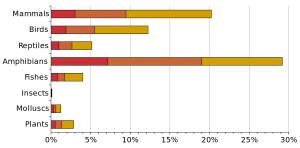A theory has recently surfaced declaring the possibility that there are around 700 species around the world that should be considered threatened species, many of whom who were possibly inaccurately declared non-threatened on the Red List of Threatened Species.
Luca Santini, an ecologist at Radboud University, was quite discouraged by this news and took it upon himself to create a more efficient and precise method when it comes to assessing the extinction risk of a particular animal. On January 17th, Conservation Biology did a segment on Santini’s new approach.
This new approach proved that as much as “20% of 600 species that were impossible to assess before by Red List experts, are likely under threat of extinction, such as the brown-banded rail and Williamson’s mouse-deer.” In addition, it found that around 600 different species that had been officially declared non-threatened species, were actually likely to be extremely threatened. As Santini, himself, said “This indicates that urgent re-assessment is needed of the current statuses of animal species on the Red List.”
The (IUCN) Red List of Threatened Species is the “world’s most comprehensive information source on the global conservation status of animal, fungi, and plant species.” That being said, every few years, researchers evaluate and record the conservation status of different species, which then gets uploaded into the Red List’s database for the general public to have access to. According to Santini, however, “Often these data are of poor quality because they are outdated or inaccurate because certain species that live in very remote areas have not been properly studied. This might lead to species to be misclassified or not assessed at all.”
Santini’s method provides experts with additional independent information in attempt to help them better assess the species. It uses information gathered from land cover maps, showing how the distribution of different species has changed over time. This then allows said researcher to have more information to be able to more accurately classify species.
Santini describes his goal for this new method in saying “Our vision is that our new method will soon be automated so that data is re-updated every year with new land cover information. Thus, our method really can speed up the process and provide an early warning system by pointing specifically to species that should be re-assessed quickly.” We can only hope that this new method provides better and more accurate information in regards to what and who we will continue to share the planet with, and who we won’t.




Leave a Reply